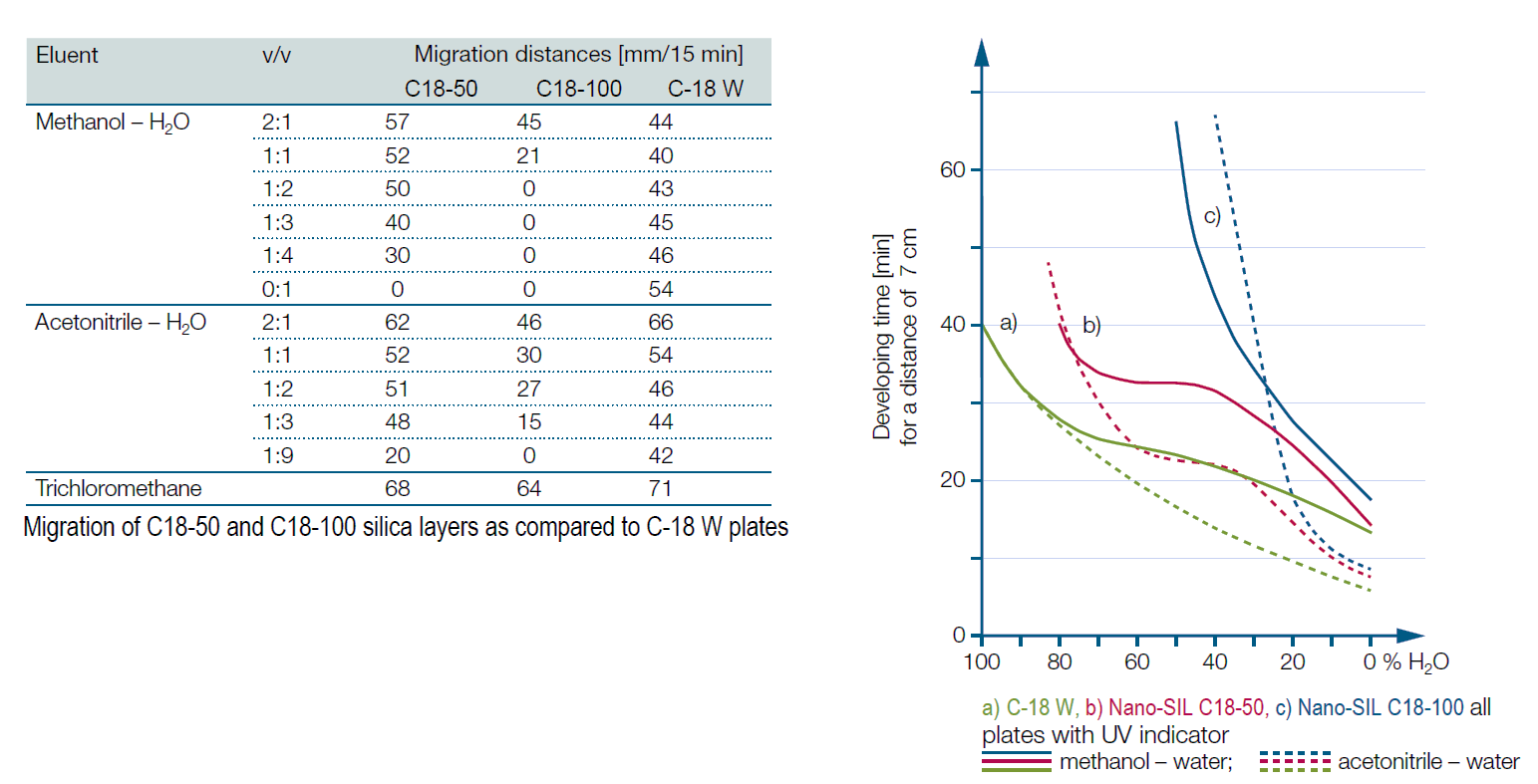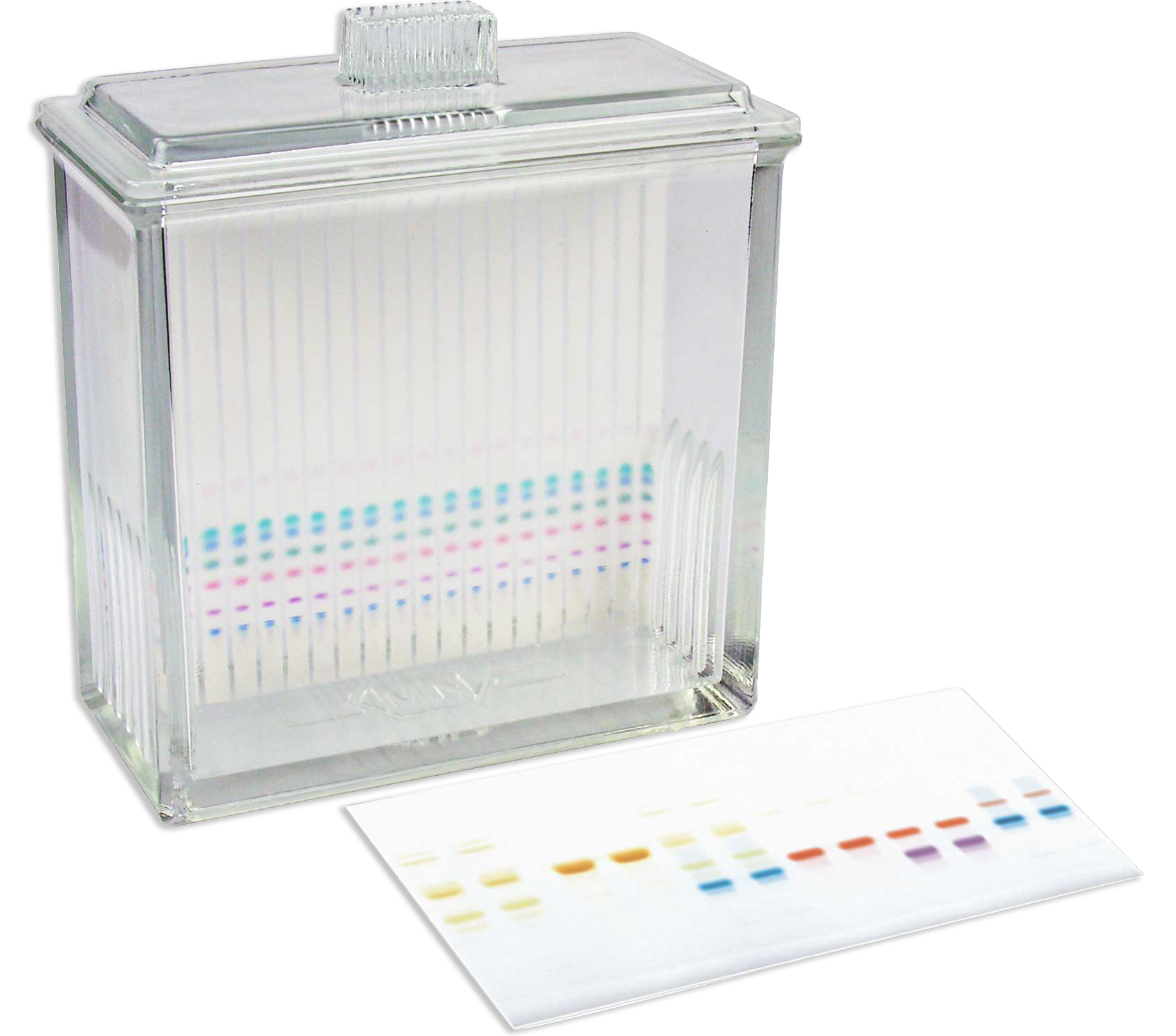C18-50 HPTLC Plates
Octadecyl-Modified Nano Silica Layers, 50% Silanization
Features:
- Partial (50 %) octadecyl modification, carbon content 7.5%
- Order of polarity: Silica > DIOL > NH2 > CN > C2 > C18-50 > C18-W > C18-100
- Reversed phase separation mode with eluents from anhydrous solvents to mixtures with high concentrations of water (see table below)
C18-50 HPTLC Plates Specifications:
- Silica Gel Technical Specifications:
- Mean pore diameter: 60Å
- Specific surface area: 500 m2/g
- Specific pore volume: 0.75 ml/g
- Particle size: 2-10µm
- Substrate:
- Glass
- Layer Thickness
- 200μm
- pH stability 2-10
- Indicator: acid-resistant product with a pale blue fluorescence for short-wave UV (254 nm)
- UV-absorbing substances appear as dark-blue to black spots on a light – blue background
Recommended Applications:
- Alkaloids, amino acids, preservatives, optical brighteners, barbiturates, polycyclic aromatic hydrocarbons (PAH), drugs, peptides, flavonoids, phenols, indole derivatives, steroids


| Catalog No. | Description | Price (USD) |
|---|---|---|
| 2614156 | C18 Silica HPTLC Plates, w/UV254, 50% silanization, glass backed, 200um, 10x10cm, 25/pk |  Buy now $586.50 Buy now $586.50 |
| 2614056 | C18 Silica HPTLC Plates, 50% silanization, glass backed, 200um, 10x10cm, 25/pk |  Buy now $586.50 Buy now $586.50 |
It is to your advantage to make certain separations on lipophilic silica layers, i.e. in reversed phase. Due to the rapid development of HPLC columns, there is an increasing demand for TLC plates which can be used for comparing the expected outcome of a HPLC chromatograph. In HPLC, reversed phase systems based on C8 or C18 modified silicas are frequently used. These systems are suited for the separation of very polar (hydrophilic) classes of compounds. Prior to the introduction of those reversed phase systems, polar compounds were separated by ion exchange chromatography. Reversed phase TLC with alkyl modified silicas as stationary phases opens many doors on potential TLC applications.
HPTLC plates C18-50 (50% silanization) and C18-100 (100% silanization)
Sorbent Technologies provides C18 silane for our reversed phase TLC plates, but with varying levels (percentages) of silanization.
We offer reversed phase plates comprising of a medium pore size silica (mean pore diameter 60 Å), with a mean particle size of 2-10 µm (identical to the material used for our HPTLC silica plates). This HPTLC silica is reacted to a different degree, either totally (= 100%) or partially (= 50% of the reactive silanol groups). This unique modified silica has found several successful applications in anhydrous eluents as well as eluents with high concentrations of water can be used (see Table 1).
As fluorescent indicator, we use an acid-resistant product which allows application of strongly acidic eluents without undesirable fluorescence quenching. This fluorescence indicator emits a pale blue fluorescence in short-wave UV light. UV absorbing substances appear as dark-blue to black spots on a light-blue background.
The two available layers differ by their selectivity, possibly due to a combination of hydrophobic and polar interactions. Table 1 clearly demonstrates differences in migration distances for different contents of water, which indicates differences in wettability.
Table 1: Benefits of Using a Wettable Layer:
Migration of C18-50 and C18-100 silica layers as compared to C18-W Plates
| Eluent | v/v | Migration distances [mm/15 min] | ||
|---|---|---|---|---|
| C18-50 | C18-100 | C18-W | ||
| Methanol/H2O | 2:1 | 57 | 45 | 44 |
| 1:1 | 52 | 21 | 40 | |
| 1:2 | 50 | 0 | 43 | |
| 1:3 | 40 | 0 | 45 | |
| 1:4 | 30 | 0 | 46 | |
| 0:1 | 0 | 0 | 54 | |
| Acetonitrile/H2O | 2:1 | 62 | 46 | 66 |
| 1:1 | 52 | 30 | 54 | |
| 1:2 | 51 | 27 | 46 | |
| 1:3 | 48 | 15 | 44 | |
| 1:9 | 20 | 0 | 42 | |
| Chloroform | – | 68 | 64 | 71 |


